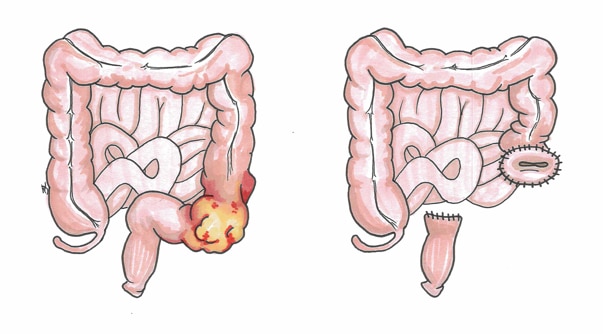This article is for educational purposes only. It should not be used as a template for consenting patients. The person obtaining consent should have clear knowledge of the procedure and the potential risks and complications. Always refer to your local or national guidelines, and the applicable and appropriate law in your jurisdiction governing patient consent.
Overview of Procedure
A Hartmann’s procedure* is a sigmoid colectomy with end colostomy formation. Typically performed as an emergency, the procedure is most commonly formed due to sigmoid perforation (e.g. secondary to diverticulitis) or a sigmoid malignancy causing bowel obstruction.
In a Hartmann’s procedure, a descending colon end colostomy is formed and the residual rectal stump is closed. Whilst a Hartmann’s procedure can be performed laparoscopically, they are usually performed via a laparotomy so ensure adequate space to operate and to allow maximum irrigation of any intra-abdominal contamination.
*The procedure is named after French surgeon Henri Albert Hartmann, who first described it back in the 1921 (different to the inventor of Hartmann’s solution despite the same name!)
Complications
Intra-Operative
| Complication | Description of Complication | Potential Ways to Reduce Risk |
| Bleeding | Ensure meticulous haemostasis during the procedure | |
| Damage to local structures | Structures at risk include small bowel and the kidney + bladder + ureter | |
| Anaesthetic risks | Includes damage to the teeth, throat and larynx, reaction to medications, nausea and vomiting, cardiovascular and respiratory complications. | Forms part of anaesthetic pre-assessment |
Early
| Complication | Description of Complication | Potential Ways to Reduce Risk |
| Pain | Pain is often worse in open procedures, compared to laparoscopic | Optimal post-operative analgesia, including epidurals or rectus sheath catheters |
| Infection | Includes both wound infections and intra-abdominal collections, as well as respiratory or urinary tract infections post-operatively | Intravenous antibiotics at induction, minimisation of faecal contamination during procedure, wound irrigation at closure |
| Ileus | Minimise contamination and bowel handling, correct any electrolyte abnormalities post-operatively | |
| Scarring | Use of laparoscopic surgery if possible to result in a smaller scar | |
| Re-Operation | Any complication may result in the return to theatre in the immediate post-operative period | |
| Rectal stump blow-out | When the suture or staple line from the rectal stump leaks or completely dehisces | Placing a temporary foley catheter into the rectal stump, to decompress the stump in the immediate post-operative period |
| DVT or PE, Myocardial Infarction, Stroke, or Mortality | As with any major surgery, whilst these events are uncommon, important to be aware of | Adequate pre-optimisation and anaesthetic assessment, peri-operative prophylactic LMWH, high-dependency level care post-operatively |
Late
| Complication | Description of Complication | Potential Ways to Reduce Risk |
| Adhesions | Attempt laparoscopic approach if possible, avoid excess tissue disruption | |
| Stoma complications | Includes stoma retraction, stoma stenosis, or stoma prolapse | |
| Incisional hernia or parastomal hernia | Ensure fascia is closed tightly, using a small bites technique | |
| Inability to restore bowel continuity | In the future, it may not be possible to rejoin the bowel together, due to either surgical or patient factors |

